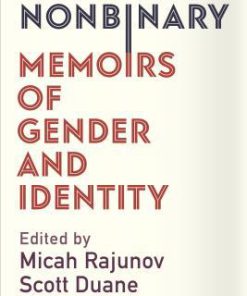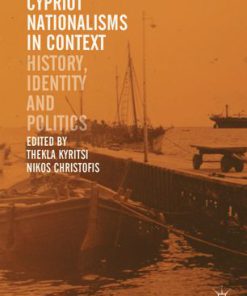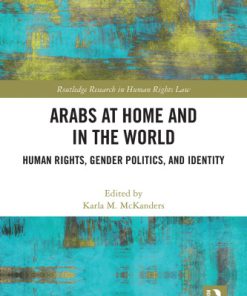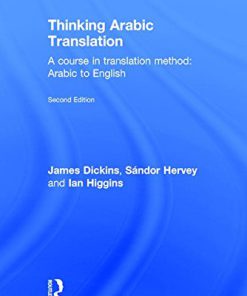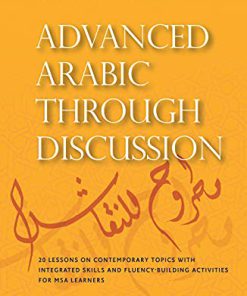Arabic Sociolinguistics Topics in Diglossia Gender Identity and Politics 2nd Edition by Reem Bassiouney ISBN 9781626167889 1626167885
$50.00 Original price was: $50.00.$25.00Current price is: $25.00.
Arabic Sociolinguistics Topics in Diglossia Gender Identity and Politics 2nd Edition by Reem Bassiouney – Ebook PDF Instant Download/Delivery: 9781626167889 ,1626167885
Full download Arabic Sociolinguistics Topics in Diglossia Gender Identity and Politics 2nd Edition after payment
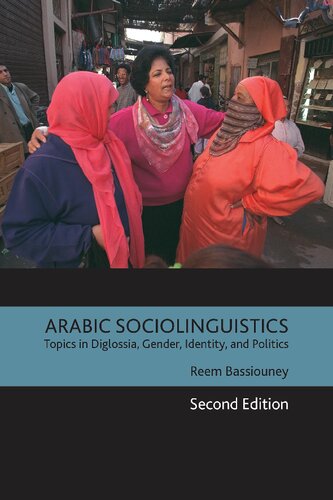
Product details:
ISBN 10: 1626167885
ISBN 13: 9781626167889
Author: Reem Bassiouney
In this second edition of Arabic Sociolinguistics, Reem Bassiouney expands the discussion of major theoretical approaches since the publication of the book’s first edition to account for new sociolinguistic theories in Arabic contexts with up-to-date examples, data, and approaches. The second edition features revised sections on diglossia, code-switching, gender discourse, language variation, and language policy in the region while adding a chapter on critical sociolinguistics—a new framework for critiquing the scholarly practices of sociolinguistics. Bassiouney also examines the impact of politics and new media on Arabic language. Arabic Sociolinguistics continues to be a uniquely valuable resource for understanding the theoretical framework of the language.
Arabic Sociolinguistics Topics in Diglossia Gender Identity and Politics 2nd Edition Table of contents:
1. Diglossia and dialect groups in the Arab world
1.1 Diglossia
1.1.1 An overview of the study of diglossia
1.1.2 Theories that explain diglossia in terms of levels
1.1.3 The idea of Educated Spoken Arabic
1.2 Dialects/varieties in the Arab world
1.2.1 The concept of prestige as different from that of standard
1.2.2 Groups of dialects in the Arab world
1.3 Conclusion
2. Code-switching
2.1 Introduction
2.2 Problem of terminology: code-switching and code-mixing
2.3 Code-switching and diglossia
2.4 The study of constraints on code-switching in relation to the Arab world
2.4.1 Structural constraints on classic code-switching
2.4.2 Structural constraints on diglossic switching
2.5 Motivations for code-switching
2.5.1 Motivations and discourse functions of classic code-switching
2.5.2 Motivations and discourse functions of diglossic switching
2.6 A holistic approach to code-switching
2.6.1 Translanguaging and the challenge of two grammatical systems
2.6.2 Motivations for switching in light of a social construct approach to language
2.7 Conclusion
3. Language variation and change
3.1 Introduction
3.2 Language variation and change
3.2.1 Social class approach
3.2.2 Social networks approach
3.2.3 Third wave approach to variation studies: community of practice
3.3 Methodology
3.4 Sociolinguistic variables
3.4.1 Ethnicity
3.4.2 Religion
3.4.3 Urbanisation
3.4.4 Social class
3.4.5 Other factors
3.5 Levelling
3.6 Conclusion to sections 3.1–3.5
3.7 Variation and the social approaches to sociolinguistics
3.7.1 Meaning, indexes and stance
3.7.2 Stance as the mediator between form and meaning
3.7.3 Studies that adopt a novel approach, method or data in Arabic sociolinguistics
3.7.4 Discussion and conclusion
4. Arabic and gender
4.1 Introduction
4.2 Approaches to language and gender
4.2.1 The deficit theory and Lakoff’s contribution to the study of language and gender
4.2.2 The dominance theory
4.2.3 The difference theory
4.2.4 Community of practice theory: third wave approach to variation studies
4.3 Women in the Arab world: framing and background information
4.3.1 Diversity in education
4.3.2 Diversity in urbanisation
4.3.3 Economic diversity
4.3.4 Diversity in traditions and religious practices
4.3.5 Honour and modesty
4.4 Politeness in relation to gender
4.5 ‘Mister master’: names, status and identity
4.5.1 Names and why they are hidden
4.6 When a chicken crows like a cock: women narrators
4.7 Language variation and change in relation to gender
4.7.1 An overview of studies on language variation in relation to gender
4.7.2 An overview of linguistic variation in relation to gender in the Arab world
4.8 Projection of identity in the speech of educated men and women in Egypt: evidence from talk show
4.8.1 Description of data
4.8.2 Categorising the data
4.8.3 Detailed description of the data
4.8.4 Conclusion
4.9 The symbolic use of language
4.10 Gender universals re-examined
4.11 Conclusion
5. Language policy and politics
5.1 The power of language
5.2 What is language policy?
5.2.1 Language ideologies
5.2.2 Language practices
5.2.3 Language planning
5.3 Nation and state
5.3.1 The relation between nation and language
5.3.2 The Arab nation
5.4 Countries with SA as the official language
5.5 French versus British patterns of colonisation and their relation to language policies
5.5.1 French patterns of colonisation
5.5.2 British patterns of colonisation
5.6 Language policies in other parts of the Arab world
5.7 The role of language academies in the Arab world
5.8 SA, politics and the aching nation: a case study
5.9 Linguistic rights and political rights
5.10 English and globalisation
5.11 Conclusion
6. A critical approach to Arabic sociolinguistics
6.1 Critical sociolinguistics
6.1.1 Problems with sociolinguistic research
6.2 The binary approach to sociolinguistics: a methodological challenge
6.2.1 The inaccuracy of the binary approach to linguistic variation
6.2.2 The confusion surrounding standard in Arabic
6.2.3 The correlation of independent variables to linguistic ones
6.3 The native speaker
6.4 Power, legitimacy and the social approach to language
6.5 The neutral linguist
6.6 Principles of methodological approaches in critical sociolinguistics
6.7 Western hegemony of the field of sociolinguistics
6.8 Conclusion
General conclusion
Bibliography
Index
People also search for Arabic Sociolinguistics Topics in Diglossia Gender Identity and Politics 2nd Edition:
arabic sociolinguistics topics in diglossia gender identity and politics
example of diglossia in sociolinguistics
what is language and gender in sociolinguistics
what is gender in sociolinguistics
Tags:
Reem Bassiouney,Arabic Sociolinguistics,Diglossia Gender,Identity,Politics
You may also like…
Politics & Philosophy - Social Sciences
Reference - Writing
History - World History
Cypriot Nationalisms in Context: History, Identity and Politics Thekla Kyritsi
Politics & Philosophy - Government & Politics
Arabs at Home and in the World Human Rights Gender Politics and Identity Karla Mckanders
Languages - Chinese Language Reference
Chinese Sociolinguistics; Language and Identity in Greater China 1st Edition Chunsheng Yang
Reference - Writing
Linguistics - Sociolinguistics
Education Studies & Teaching - Education - General & Miscellaneous
Gender Identity Beyond Pronouns and Bathrooms Maria Cook 161930757X 9781619307575
Uncategorized




